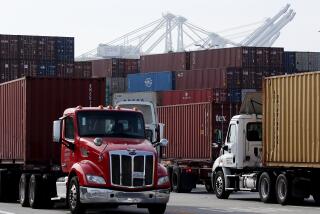Tanker Due to Make 1st Trip Along Coast : Fuel: The Chevron Oregon landed at the Gaviota terminal Monday to pick up 250,000 barrels before heading to Los Angeles refineries.
More than a decade after Chevron and other oil companies first proposed shipping oil from their giant Point Arguello field to Los Angeles, a tanker with 10.5-million gallons of crude oil was expected to pass along the Ventura County coastline early this morning.
Officials from oil companies involved in the project called the departure of the tanker Chevron Oregon a milestone.
“I speak for the guys out there (on the ship) that we are really pleased to be able to do this,” Chevron spokesman Steven A. Hillyard said.
Opponents of the project, who had turned out at countless hearings to express concerns about catastrophic oil spills, stayed clear of Gaviota on Monday.
One of the opponents said it didn’t make sense for his group to be present at Monday’s loading.
“It was sort of anti-climactic,” explained Robert Sollen of the Sierra Club.
Still, Sollen said Santa Barbara-area environmentalists plan to ride herd on the oil companies to make sure that Chevron--the company shipping the oil--complies with its California Coastal Commission permit.
The Coastal Commission has permitted Chevron to move 10.5 million gallons of crude oil, or 250,000 barrels, every five days until Jan. 1, 1996. In the meantime, the companies have agreed to build a pipeline to carry the oil to Los Angeles.
“We will keep monitoring them and make sure they meet all the (conditions) set down in the state Coastal Commission permit and make sure everything goes as scheduled,” Sollen said.
Just two weeks earlier, environmentalists had loudly protested a practice run for Monday’s loading of crude. Riding in a fleet of kayaks, the protesters held signs that read “No More Spills.”
For the past 10 years, Santa Barbara officials and environmentalists have opposed the project, saying it poses the danger of an oil spill as serious as the Exxon Valdez disaster in Alaska.
Obviously pleased that they had outlasted their challengers, representatives from some of the oil companies observed Monday’s loading with a sense of victory.
Dan Mihalik, who manages the Gaviota terminal for Texaco, one of the companies in the consortium shipping the crude oil, said every precaution against a spill or other disaster has been taken.
“Any process like this has risks,” he acknowledged. But he said the Gaviota facility has employed the most sophisticated technology to prevent a disaster.
“We’re all aware that the consequences of an oil spill can be catastrophic, but we’ve done everything possible to reduce those risks,” said Mihalik, who watched Monday’s loading from a bluff several hundred yards away.
Under a bright sun, a group of oil-company staffers and local emergency officials had gathered by late morning awaiting the tanker.
Traveling down the ocean corridor, the Chevron Oregon pulled into the Gaviota terminal shortly past noon.
Even at its speed of about 13 knots--about 20 land miles per hour--the huge vessel appeared to be moving at a snail’s pace.
“These are big ships . . . and the only way you can control them is to go slow,” explained Maurizio Croce, manager of Chevron’s West Coast Port Operations Division and supervisor of the Oregon’s 22-member crew. “They’re not jet fighters.”
The ship dropped anchor and parked along a boom positioned several hundred yards offshore. Crew members connected hoses from Gaviota’s oil storage tanks and vapor-recovery system to the ship’s double-hulled tankers.
The oil began going into the ship at 3 p.m. and it was expected to take about 12 hours for all 250,000 barrels to be pumped in. The ship is expected today to travel down the corridor through the Santa Barbara Channel to Los Angeles refineries.
Chevron officials say they operate 41 vessels worldwide and fewer than four barrels of crude and petroleum products were spilled last year.
At Gaviota, Mihalik said, vapors from the crude oil are sucked into an onshore compressor by a system that resembles a gas-station fuel pump. The system prevents vapors from escaping into the atmosphere.
According to Mihalik, only .1% of the vapors escape into the atmosphere. Santa Barbara County requires the Gaviota terminal to reduce vapors in an equivalent amount to those released by its facilities, he said.
More to Read
Sign up for Essential California
The most important California stories and recommendations in your inbox every morning.
You may occasionally receive promotional content from the Los Angeles Times.










